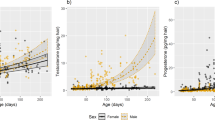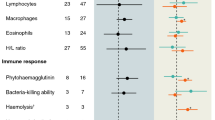Abstract
IN NATURE of October 8, 1938, Duszynska gave an account of seasonal variation in the response of ovariectomized mice to œstrone, and described an annual cycle of sensitivity which was greatest in spring and lowest in autumn. In the accompanying figure, I have plotted the variations in the dose of international standard œstrone needed to give 50 per cent positive responses when given by injection to groups of ovariectomized mice belonging to colonies kept at this Institute during the past twenty months.
This is a preview of subscription content, access via your institution
Access options
Subscribe to this journal
Receive 51 print issues and online access
$199.00 per year
only $3.90 per issue
Buy this article
- Purchase on Springer Link
- Instant access to full article PDF
Prices may be subject to local taxes which are calculated during checkout
Similar content being viewed by others
References
Emmens, Med. Res. Coun. Sp. Sep. Ser., No. 234. In the Press. H. M. Stationery Office, London, 1939.
Author information
Authors and Affiliations
Rights and permissions
About this article
Cite this article
EMMENS, C. Time-to-Time Variation in the Response of Ovariectomized Mice to œstrone. Nature 143, 476–477 (1939). https://doi.org/10.1038/143476a0
Issue Date:
DOI: https://doi.org/10.1038/143476a0
Comments
By submitting a comment you agree to abide by our Terms and Community Guidelines. If you find something abusive or that does not comply with our terms or guidelines please flag it as inappropriate.



